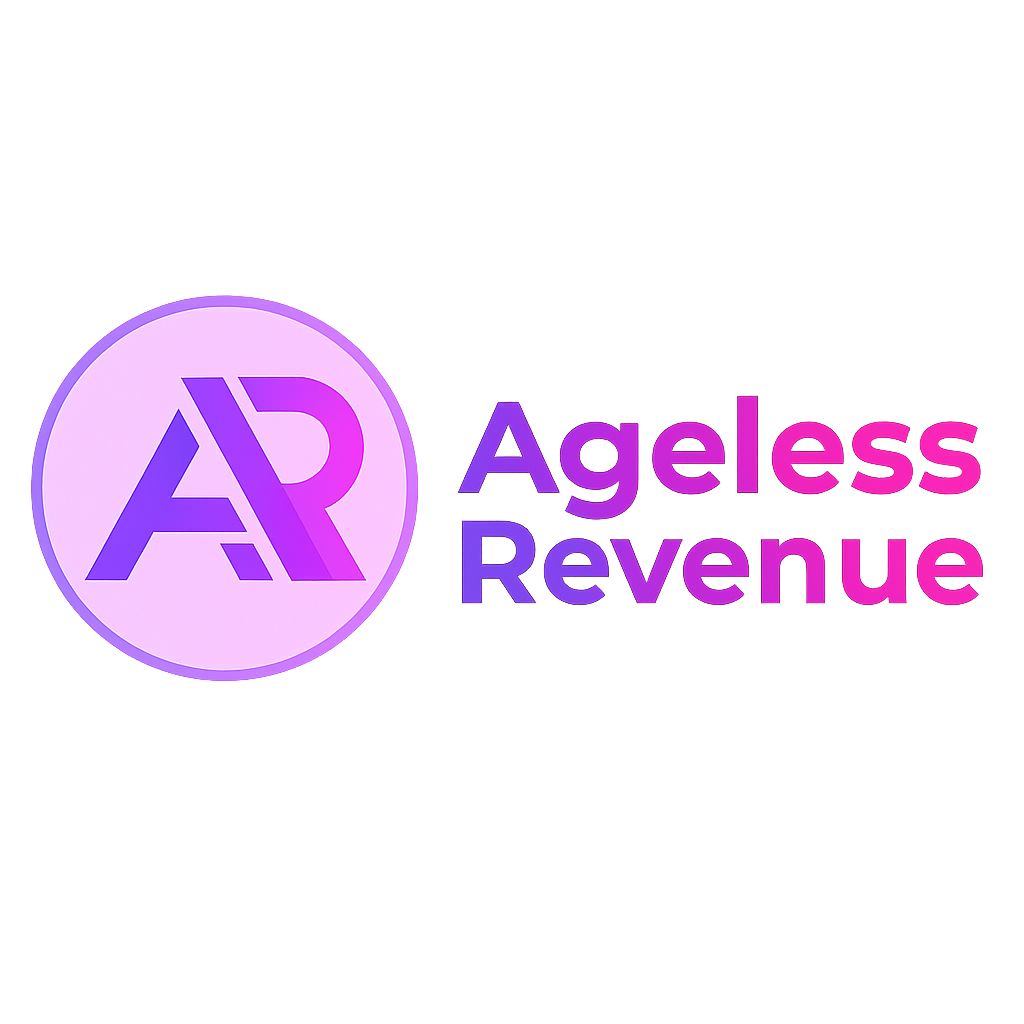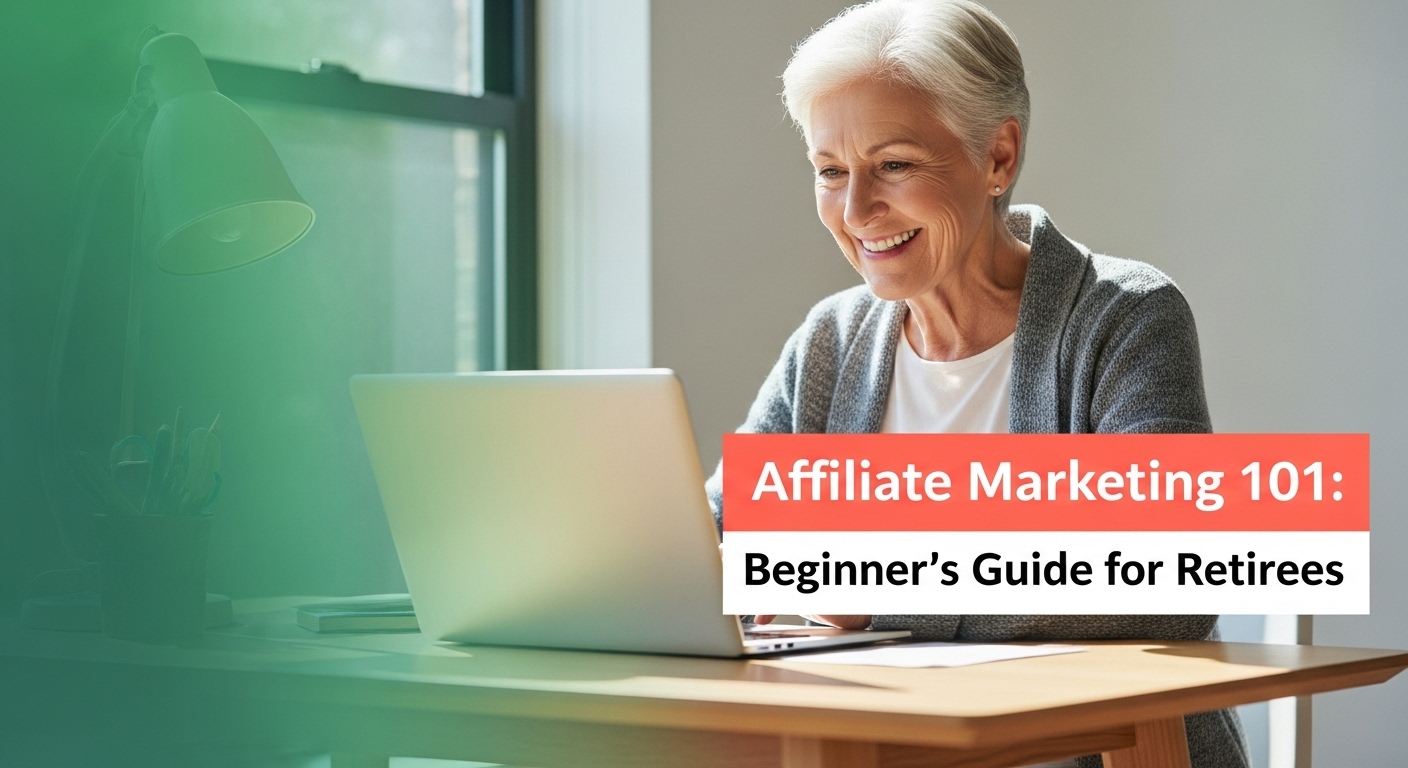Affiliate marketing 101 in plain English: you recommend helpful products online, your reader clicks a special link, and when they buy, you earn a commission. No inventory, no shipping, and no customer support. This pillar guide is written for retirees who want calm progress—one small task at a time—without tech overwhelm.
In this Affiliate Marketing 101 guide, you’ll discover how retirees can turn everyday interests into online income—without technical skills or big upfront costs.
Affiliate Disclosure: This post contains affiliate links. If you buy through them, I may earn a small commission at no extra cost to you. I only recommend tools I believe are genuinely helpful.
TL;DR – Affiliate Marketing 101 for Retirees
- Affiliate marketing 101 for retirees means recommending products you trust, using special links, and earning a commission when readers buy—no inventory or shipping.
- Your first steps are simple: choose a calm, beginner-friendly niche, set up a basic WordPress site, and join 1–2 starter affiliate programs.
- Publish helpful content that answers real questions: reviews, comparisons, how-tos, and “best for beginners” guides with clear recommendations and gentle calls to action.
- Follow a light weekly routine for 8–12 weeks: one post, a few images, basic SEO, and simple promotion—consistency matters more than speed.
What Is Affiliate Marketing 101 for Retirees? (The Friendly Primer)
Think of affiliate marketing as a referral program on the internet. A company (the merchant) lets you (the affiliate) share links to its products. Your link includes a tracking ID. If someone purchases after clicking your link—within a set time window—you’re credited with the sale and paid a commission. It’s a great fit for retirees because you can turn decades of life experience into helpful recommendations that genuinely guide people.
At its core, Affiliate Marketing 101 is about helping people find useful products and earning a fair reward when they make a purchase through your honest recommendation.
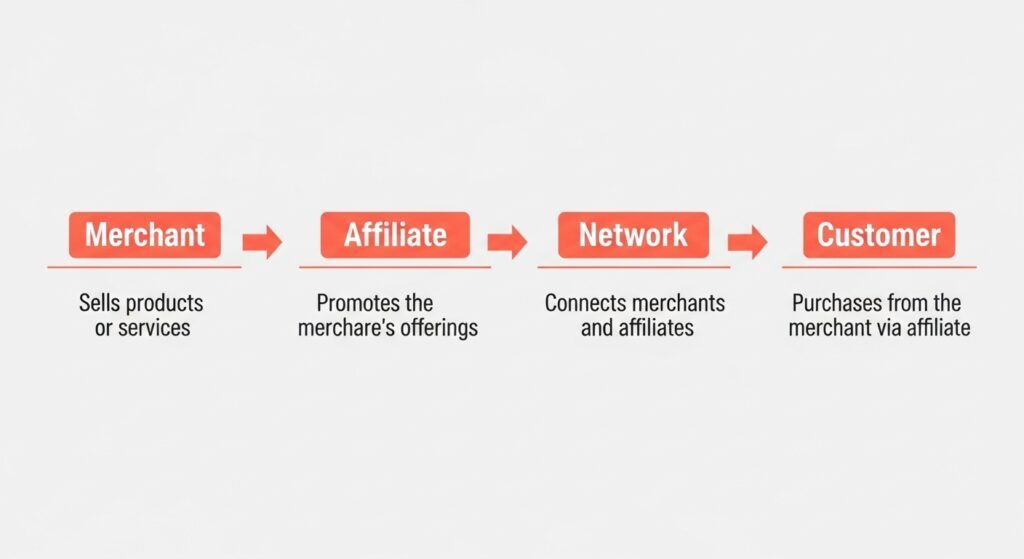
- Merchant (Advertiser): Sells the product or service.
- Affiliate (You): Recommends and earns commissions on tracked sales.
- Affiliate Network (optional): A platform (e.g., Impact, ShareASale) that provides tracking and payments for many brands.
- Customer: The reader who clicks your link and buys.
Reality check: Affiliate marketing is not “get rich quick.” It’s a gentle, compound-growth model. Helpful content brings readers, a portion click; a portion purchase. Over a few months, a small library of useful posts can start earning quietly in the background.
If you’re a total beginner and want a printable checklist, you can also grab my Affiliate Marketing Starter Kit for Beginners, which turns this 101 lesson into a simple step-by-step workflow.
How Tracking & Commissions Work (No Jargon)
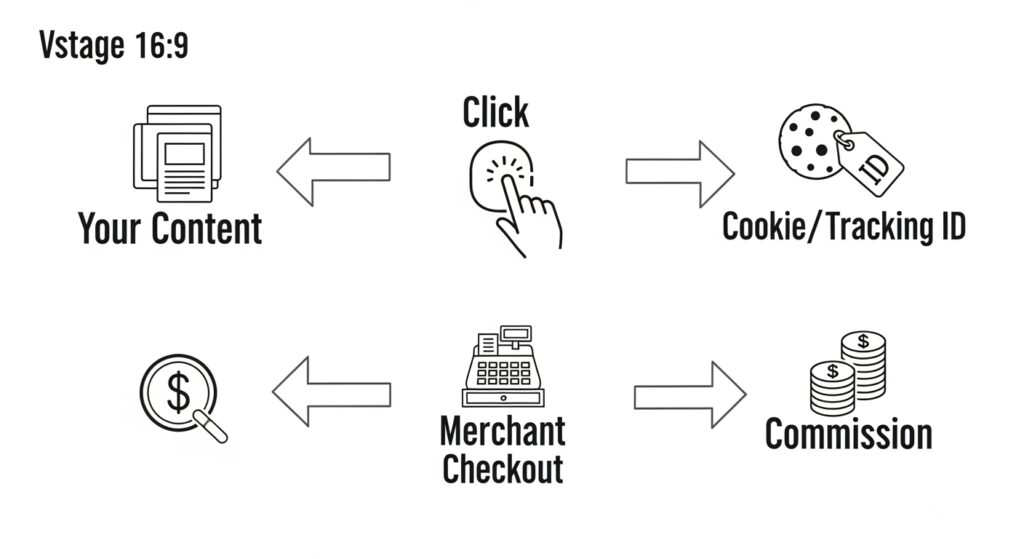
- Click: Your reader clicks your special link in a blog post, email, or social post.
- Cookie or ID: The program records your referral (for example, 24-hours, 7-days, 30-days+ depending on the merchant).
- Purchase: If a purchase happens within the window, the sale is attributed to you.
- Payout: Payments usually happen monthly after a brief “locking” period for returns.
Example: You write a clear review of a low-impact exercise band set. Your link leads to the product page. A reader buys the same day—your cookie is valid for 24 hours—so the sale is credited to you. If the band set is $30 and commission is 8%, you earn $2.40. Repeat this across several helpful posts and the small numbers add up.
One of the most valuable lessons in Affiliate Marketing 101 is learning to build trust first; when readers believe in you, sales follow naturally.
Choose a Calm, Beginner-Friendly Niche
Pick a topic where you feel comfortable answering beginner questions. Start with everyday problems and practical tools. Use Google Trends to confirm interest, browse Amazon reviews to hear the wording people use, and peek at Reddit or Facebook groups to see common questions.
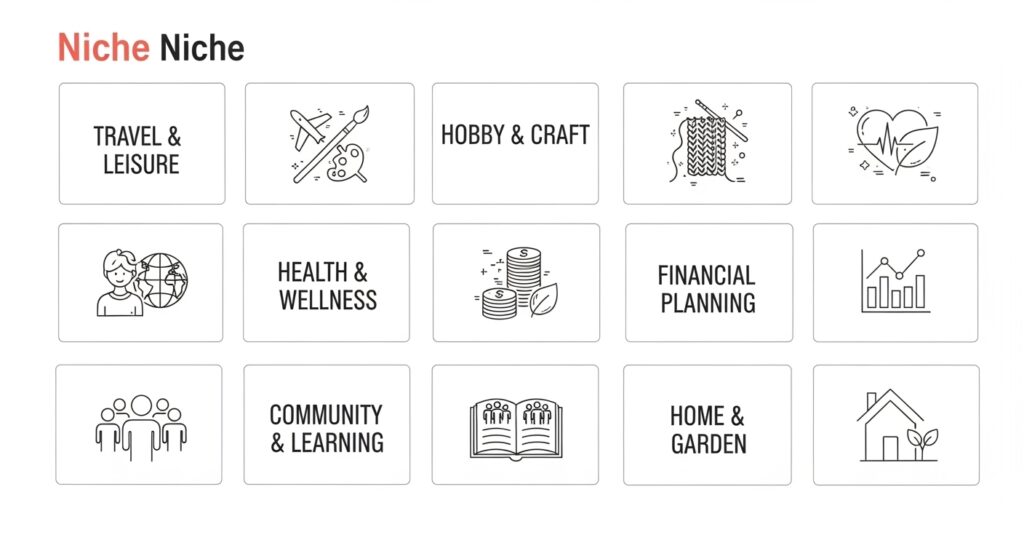
- Gentle fitness: light resistance bands, balance aids, stretching tools
- Accessible gardening: raised planters, ergonomic tools, gloves
- Beginner crafts: watercolor, quilting, crochet starter kits
- Simple cooking: slow cookers, steamers, compact air fryers
- Travel comfort: pillows, packing aids, compact mobility helpers
- Home office basics: ergonomic keyboards, webcams, chairs
Helpful next read: when you want to double-check demand, see Validate Your Online Business Idea for a simple step-by-step check.
For more concrete ideas, see Top 10 Online Business Ideas for Retirees, where I break down niches that work especially well in retirement.
Once you’ve sketched a calm niche, these guides will help you shape and test it before you invest months of effort:
- Business Idea Questions: 25 Essential Checks for Beginners (2025) — stress-test whether your niche is realistic for your energy and skills.
- The Best Ways To Conduct Market Research For Your Online Business — find real questions, phrases, and complaints from your future readers.
- How To Validate Your Online Business Idea: A Step-by-step Guide — run a small test so you don’t overbuild a niche with no demand.
Set Up Your Home Base (Quick & Calm)
You only need a few basics to get started. A simple WordPress website makes approvals easier and gives you an asset you control long-term.
- Domain & hosting: choose a clear domain; beginner-friendly hosts include Bluehost, SiteGround, or Hostinger.
- WordPress + theme: install WordPress; pick a clean theme (Astra, Kadence, or GeneratePress).
- Core pages: About, Contact, and a short Disclosure page.
- Rank Math: helps with titles, meta descriptions, and schema.
- Pretty Links or ThirstyAffiliates: keeps affiliate links tidy and easy to update.
New to graphics? My walkthrough on making fast blog images is here: Speed Up Blog Graphic Creation with Canva.
With your home base in place, the next step is to connect it to a simple, written plan and clear next actions:
- Essential Elements Of A Successful Online Business Plan — see how your new site fits into a bigger picture.
- Online Business Plan Template: Simple 1-Page Guide (2025) — map your audience, offers, and traffic on one page.
- Tools And Resources For Retirees Starting An Online Venture — keep your toolset small, simple, and retiree-friendly.
Join Your First Affiliate Programs
Start with one recognizable marketplace and one network. Read their rules, especially regarding disclosure and where you may share links (some programs limit email or PDF use).
- Amazon Associates — huge catalog, fast approvals, shorter cookie.
- Impact or ShareASale — access to many brands with longer cookies and higher commissions in some niches.
Approval tips: have at least two helpful posts live, a plain About page, and a short disclosure. Show you’re a real person offering real value. If declined, tidy the site, publish one more post, and reapply in a week.
Content That Earns Trust (and Where Links Belong)
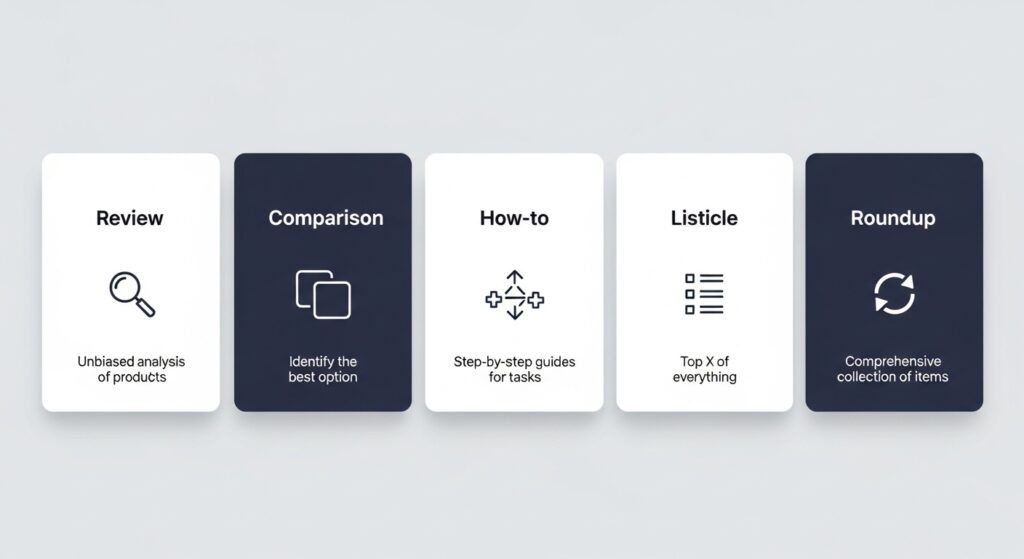
- Review: Start with a simple verdict, then pros/cons, who it’s for, and one clear photo. Place 1–2 links near the verdict and in a “What I Recommend” box.
- Comparison (A vs. B): Help readers choose based on 3–5 points that truly matter (setup time, noise, comfort, warranty).
- How-to: A short tutorial that naturally mentions tools and links to them. Aim for quick wins.
- Roundup: “7 Best … for Beginners.” Use one paragraph per pick, a tight pros/cons box, and a “Best For” label.
Internal links keep readers exploring your site (and help search engines understand your topic). Link out to external resources when they genuinely help—Google Trends or FTC guidance, for example.
Basic On-Page SEO (The Simple Version)
Put the phrase affiliate marketing 101 in your title, your first paragraph, one subheading, and at least one image ALT. Keep paragraphs short, use headings every few sections, and add a small FAQ at the end. Rank Math will guide you through key items—don’t chase a perfect score; aim for clear, readable pages.
To go deeper on getting visitors from Google, read How To Conduct Keyword Research For Maximum SEO Impact: The Definitive 2025 Guide—it’s written with beginners in mind.
If you’d like more detailed SEO and content help beyond this quick overview, these guides break it down step by step:
- How To Conduct Keyword Research For Maximum SEO Impact: The Definitive 2025 Guide — find the long-tail questions your readers are already searching for.
- Engaging Content that Converts for Affiliate Sales: Step-by-Step Guide (2025) — structure posts so they help first and sell gently.
- Best AI Tools for Blogging: Boost Efficiency, SEO, and Engagement (2025) — use AI carefully to save time while keeping your voice.
Your Gentle 8-Week Plan
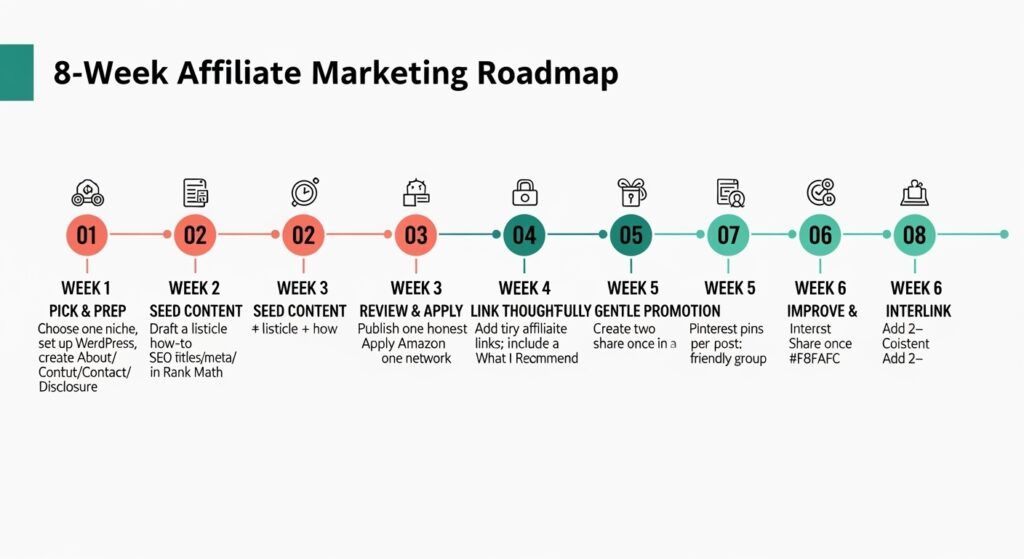
Week 1: Pick & Prep
- Choose one niche and list 10 beginner questions (from reviews, groups, Reddit).
- Register your domain, install WordPress, pick a clean theme.
- Create About, Contact, Disclosure pages.
Week 2: Seed Content
- Draft two posts: a helpful listicle and a simple how-to.
- Set up Rank Math; write clear SEO titles and meta descriptions.
Week 3: Review & Apply
- Publish an honest review with pros/cons and “Who it’s for.”
- Apply to Amazon Associates + one network (Impact or ShareASale).
Week 4: Link Thoughtfully
- Add 1–2 affiliate links per product mention—no stuffing.
- Add one small “What I Recommend” box to your best post.
Week 5: Gentle Promotion
- Create two Pinterest pins per article in Canva (teal→emerald with coral accents).
- Share in one friendly community where allowed—no spamming.
Week 6: Improve & Interlink
- Link related posts together (2–3 internal links each).
- Add a small FAQ at the end of each article—answer real questions.
Week 7: Tighten Titles & Images
- Rewrite any vague titles; keep benefits clear (“…for Beginners”).
- Swap blurry images; ensure at least one image ALT includes “affiliate marketing 101”.
Week 8: Track & Adjust
- Check clicks and conversions. If clicks are high but sales low, clarify your top pick and add a cheaper alternative.
- Plan the next three posts based on questions readers keep asking.
Traffic Without Hustle
Search (SEO): Your articles can rank for long-tail questions like “best low-impact exercise bands for seniors.” Keep publishing steady, helpful answers and you’ll collect traffic over time. Pinterest: still excellent for evergreen how-tos and checklists—pin calmly each week. Email: a tiny newsletter keeps readers returning and is a great place to share new reviews and comparisons.
And if you’d like to see real examples of programs that fit retirees, my article Best Passive Income Affiliate Programs for Retirees Over 60 walks through different types and how to evaluate them.
Common Mistakes (and Friendly Fixes)
- Going too broad: serve one small audience first. Once you have momentum, expand to a nearby topic.
- Link stuffing: place links where decisions happen—in a verdict, near a comparison table, or beside a clear image.
- No disclosure: add a one-line disclosure at the top and keep a site-wide disclosure page.
- One-and-done publishing: one helpful article per week grows faster than bursts and long pauses.
- Ignoring data: if a post gets clicks but no sales, tighten the headline, simplify the choices, add a “Best pick,” and improve the main image.
Helpful Internal & External Links
- Affiliate Marketing Starter Kit (internal)
- Create Content That Converts (internal)
- Speed Up Graphics with Canva (internal)
- Google Trends (external)
- Amazon Associates (external)
- FTC Endorsement Guides (external)
FAQs (Affiliate Marketing 101)
Do I need my own product?
No. You recommend other companies’ products using a tracked link. When a reader buys through that link, you earn a commission—no shipping or support required.
How long until I see results?
Many beginners see first clicks within a few weeks and the first sale within a month or two. Consistency (one helpful post each week) matters far more than speed.
Is a website required?
You can start on social, but a simple WordPress site is the best long-term engine. It helps with program approvals and gives your content a permanent home you control.
Where should I put affiliate links?
Near the decision points: next to your verdict, in a “Best For” box, and once near the conclusion. Keep it tidy and transparent.
What should I publish first?
One helpful listicle, one how-to, and one review with pros/cons and who it’s for. Add a short disclosure to each post.
If you remember just one thing from Affiliate Marketing 101, it’s that consistency—not speed—is what creates long-term passive income success.
Your Next Small Step
Pick one tiny niche, outline one helpful post today, and publish this week. That’s your true start to affiliate marketing 101. Then add one post per week and keep improving the ones you have. Calm progress beats hustle every time.
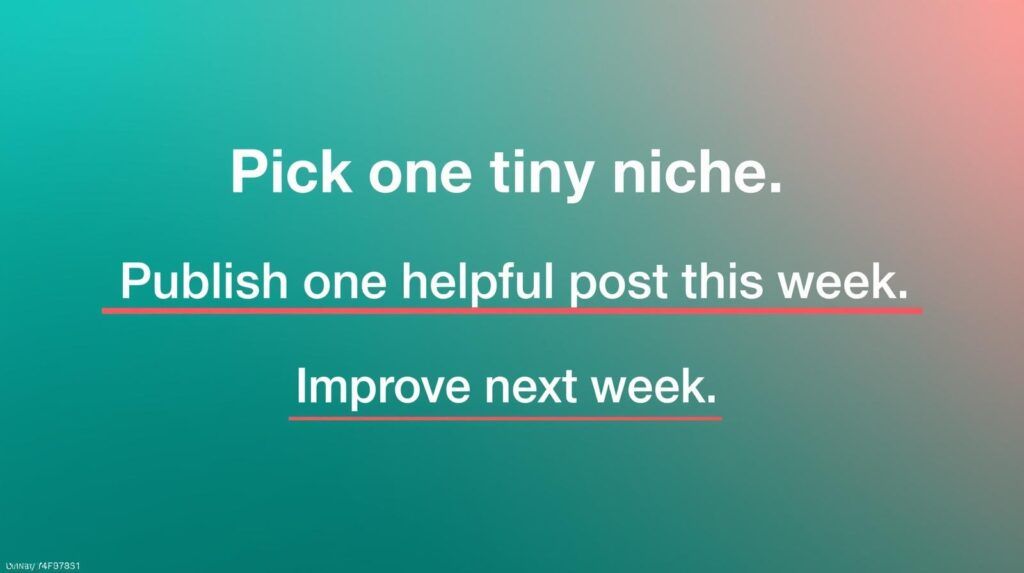
You’ve now completed your first look at Affiliate Marketing 101—the perfect starting point for retirees ready to create something profitable and meaningful online.
Now that you’ve completed your Affiliate Marketing 101 guide, you’re ready to take your first real step toward building an income online. The best place to start learning, practicing, and growing your skills is inside Wealthy Affiliate — a friendly training platform designed for beginners and retirees alike. It gives you all the tools, coaching, and community support you need to build your affiliate business with confidence.
From Reading About Affiliate Marketing to Actually Starting
Affiliate Marketing 101 is not about perfect funnels or fancy tricks. It is about choosing one calm niche, setting up a simple home base, and publishing helpful answers for real people.
- Protect a small weekly routine: one helpful post, a few image updates, and a quick look at your clicks.
- Let trust lead: recommend only products you would suggest to a friend or family member.
- Give yourself 8–12 weeks of steady effort before you judge your progress.
Over time, those quiet, consistent steps can turn into a meaningful stream of income that supports your retirement—without sacrificing your peace of mind.
If you’d like a printable checklist to guide your first weeks, download my free Affiliate Marketing Starter Kit for Retirees. It turns this Affiliate Marketing 101 guide into a calm, step-by-step workflow you can follow.
Affiliate Disclosure
Some links on this page are affiliate links. If you click and make a purchase, I may earn a commission at no extra cost to you. I only recommend tools and resources I genuinely believe help retirees succeed online.
If you’re serious about turning this knowledge into action, join Wealthy Affiliate here and start creating your first online income stream today.
